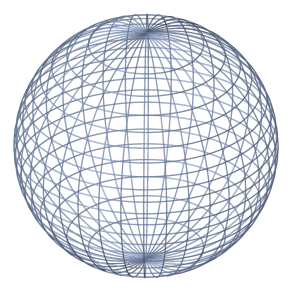Volume of a Sphere
A sphere is a perfectly round geometrical object in 3-dimensional space. It can be characterized as the set of all points located distance \(r\) (radius) away from a given point (center). It is perfectly symmetrical and has no edges or vertices.

Note: The earth is not a sphere! As mentioned above, a sphere has no edges or vertices. But the earth is slightly flattened on the poles, which makes its shape un-sphere-ish. Its shape is given a special name: the geoid.
A sphere with radius \(r\) has volume \( \frac{4}{3} \pi r^3 \) and surface area \( 4 \pi r^2 \).
Interesting fact: Of all shapes with the same surface area, the sphere has the largest volume.
What is the volume of a sphere of radius \(5\)?
The volume of a sphere of radius 5 is \( \frac{4}{3} \pi \times 5^3 = \frac{ 500 } { 3} \pi = 166 \frac{2}{3} \pi \). \( _\square \)
If the surface area of a sphere is \(144\pi,\) what is the volume of the sphere?
Observe that the surface area of the sphere can be rewritten as\[144\pi=4\pi \times 6^2.\]
Then, since the surface area of a sphere with radius \(r\) is \( 4 \pi r^2 ,\) it follows that the radius of the sphere in this problem is \(r=6.\) Hence, its volume is
\[\frac{4}{3} \pi r^3 =\frac{4}{3} \pi \times 6^3 =288\pi. \ _\square\]
You have a gold sphere whose volume is \(\frac{4\pi}{3} \text{ cm}^3.\) If you want the gold sphere to be twice as large in size, how much more gold do you have to bring to a jeweler in addition to the gold sphere you currently have?
From the formula \( V=\frac{4}{3} \pi r^3 \) for the volume of a sphere with radius \(r,\) you know that the radius of your gold sphere is \(r=1 \text{ cm}.\) Since you want the radius to be \(2 \text{ cm},\) the amount of gold required to make the new, bigger sphere is \( \frac{4}{3} \pi \times 2^3 =\frac{32\pi }{3}\left(\text{cm}^3\right).\) Hence, the additional amount of gold required is\[\frac{32 \pi}{3}\text{ cm}^3-\frac{4\pi}{3}\pi \text{ cm}^3=\frac{28\pi}{3} \text{ cm}^3. \ _\square\]
The volume of sphere \(a\) is \(\frac{1}{27}\) times that of sphere \(b.\) The surface area of \(a\) is how many times the surface area of \(b?\)
Let \(R_a\) and \(R_b\) denote the radii of spheres \(a\) and \(b,\) respectively. Then from the formula \( V=\frac{4}{3} \pi r^3 \) for the volume of a sphere with radius \(r,\) we have\[\frac{4}{3} \pi {R_a}^3=\frac{1}{27}\cdot \frac{4}{3} \pi {R_b}^3,\]
which implies \(R_a=\frac{1}{3}R_b.\)
Therefore, from the formula \( S=4 \pi r^2 \) for the surface area of a sphere with radius \(r,\) we conclude that the surface area of sphere \(a\) is \(\left(\frac{1}{3}\right)^2=\frac{1}{9}\) times the surface area of sphere \(b.\) \(_\square\)
 If the largest sphere is carved from a wooden cube measuring 10 units on an edge, what is the ratio of the volume of this sphere to the volume of the cube?
If the largest sphere is carved from a wooden cube measuring 10 units on an edge, what is the ratio of the volume of this sphere to the volume of the cube?
Give your answer as a fraction.
Use \(\pi=\frac{22}{7}\).
An artist has delicately taken out a conical portion from a spherical watermelon with radius \(R=5,\) as shown.
Instead of a flat circular base, this special cone has a spherical cap (retaining its peel) with a cross-sectional base radius of \(r = 3.\)
What is the ratio of the volume of the original whole sphere to that of this spherical cone?
